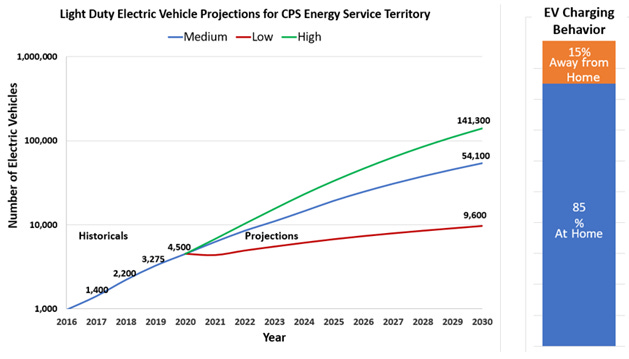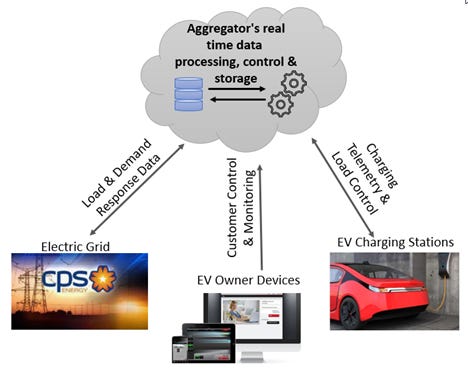EV Charging and Other Current Pilots at CPS Energy
by Richard Medina, Vice President, Grid Transformation and Engineering Group, CPS Energy
This article will provide a brief overview of EV charging strategies currently being evaluated at CPS Energy, as well as other technology pilot initiatives. It is based on a presentation delivered at SGO’s Grid Modernization Forum in May 2021.
EV Projected Growth and Infrastructure Requirements
CPS Energy is positioning itself to meet the challenges posed by growing EV adoption, as illustrated in the figure below.
Source: EPRI (Used as CPS Energy Forecast)
As indicated, 54,100 EVs are projected to be in CPS Energy’s territory by 2030 using the EPRI medium forecast. 85% of the charging energy (kWh) will be dispensed at home, and 15% in commercial locations. These projections will lead to the following infrastructure requirements by 2030:
Public DCFC -- 115 Ports
Public Level 2 -- 2,030 Ports
Residential Level 2 -- 27,060 Ports
The figure below shows the estimated demand (i.e., peak kW grid capacity) that needs to be built out to support each of the charging types.
Source: DOE Alternative Fuels Data Center EV Infrastructure Pro-Lite. Assumptions: Full support for 75% BEV’s and 25% PHEV’s in 2030
A Flexible PathSM towards Grid Modernization
EV infrastructure investments are part of CPS Energy’s overall Flexible Path journey towards grid modernization, balancing current technologies with new ones as we move forward. This involves moving from large power plants to distributed energy, more renewables, battery storage, electric vehicles, two-way communications between the utility and customer, and more demand response.
Our program strategy for EVs is to enable the electrification of transportation in our community by delivering customer options that allow us to optimize our infrastructure while delivering a meaningful customer experience. This involves:
Expanding customer value to increase EV utilization and adoption
Understanding customer needs through analytics and focus groups to eliminate barriers
Engaging with customers to create valuable rates and incentives to reduce grid impacts
Collaborating and partnering with industry, customers, and other utilities
Facilitating the development of EV infrastructure into our community
Our goal is to electrify, but also to optimize our infrastructure. To achieve this, the company is pursuing three sub-strategies:
- Product Offerings
Create customer-centric offerings that increase value for customers and encourage off-peak charging with benefits to customers, community, and grid.
- Operations & Infrastructure
Provide infrastructure solutions to support customer initiatives, facilitate EV adoption, and minimize impacts on the electric grid.
- Education & Marketing
Drive adoption of EVs by educating employees, consumers, businesses, and partners
Home Charging Solutions
CPS Energy currently has three EV charging pilot offers in progress, which allows EV drivers to select the approach that works best for them and meets their needs. The first is FlexEVSM Smart Rewards, a managed charging offer for what we call the “Busy Bee” customer segment – those who are not interested in controlling their appliances, AC units or electric vehicle chargers. We give them a discount on a WiFi smart charger so that we can control it remotely on small number of high electricity demand days during peak hours. For example, we can dial it down from a Level Two to Level One, or even shut it off for an hour or two. This program makes it easy for the Busy Bee to “do the right thing,” which is one of the main customer benefits for this segment. Participating customers receive a monthly bill credit reward for participating in this program. Customers have the option to “opt out” of a demand response event but lose the monthly bill credit for that month.
The second offer is FlexEV Off-Peak Rewards and is designed for customers who don’t want utilities controlling their AC unit, EV charger or appliances. In this program, we offer a smaller rebate on a WiFi smart charger, but a larger monthly credit on electric bills to reward customers for scheduling their EV charging off-peak. We can measure the customer response to this through the AMI meters or the charging device itself.
The third offer under development is a time of use rate, which maximizes the savings opportunity for customers and gives them full control. This is for the highly engaged customer who wants to be in control.
These three pilots have recently been initiated, and CPS Energy is on track to get 500 participants. We aim to run the pilots during summer 2021 and see which type of program EV drivers are really interested in.
Managed EV Charging Options
An interesting fact illustrates the potential impact of EV charging on CPS Energy’s grid: If San Antonio’s entire light duty vehicle fleet were electrified, it could create an additional demand of 900 MW on peak. This would compel us to upgrade a great deal of infrastructure on the network. In light of this, we are always evaluating technologies that can help meet this potential challenge. There are three options in particular that CPS Energy is evaluating.
The first option is the use of a low-cost intelligent circuit breaker. This is a utility-funded device at EPRI, which offers secure communications based on open standards. The breaker enables utility-grade metering and is designed with utility integration in mind, so that EV loads can be managed by the utility. In this scenario, the intelligent circuit breaker lets us know where the grid is stressed and where we need to put in a Level 2 charger, or similar infrastructure, to meet the demand.
The second option being evaluated is demand response-capable home chargers, shown in the figure below.
In this scenario, the utility uses platforms and smart chargers to control the charging.
The third option, shown below, is to control charging via apps. As the market matures, this seems to be where the future is headed.
Telematics and the vehicle itself will allow utilities to perform geofencing and related strategies to control chargers during peak events, which may avoid the need to buy smart infrastructure for extensive parts of the network. Since the EVs will have most of the analytics onboard, they can communicate with the grid and report their current charging state, which can be used to balance charging across vehicles. For example, if one car is at 10% state of charge (SOC) and another is at 80%, we would not shut off charging to the second vehicle, but rather slow it down appropriately.
CPS Energy / City of San Antonio (CoSA) Partnership
CPS Energy is excited about a smart city pilot we are currently undertaking with the City of San Antonio. This strategic partnership will leverage technology that brings value and benefits to our shared customer base by:
Expanding the intelligence of network assets
Promoting the means for better cost management
Improving information and services to customers
As a utility, CPS Energy owns and operates streetlight infrastructure. We have about 130,000 lights and are looking at deploying smart technology to control them. For example, we have conducted pilots on dynamic dimming using sensors, so that if the lights are all on and there's no traffic in the middle of the night, the lights can be dimmed down and then brightened if a vehicle is coming.
These types of technologies can improve energy efficiency of lighting systems. One bulb doesn't make a difference, but if you have 130,000, that does make a difference.
We are also working to deploy a system that provides benefits to the City of San Antonio, such as noise and environmental sensors that can help the City understand what is happening in the different sectors of town. You can overlay additional applications on these platforms, like shot spotter, which is a gunshot detection technology for the police department. We are also piloting flood sensors and parking sensors, so that people can use apps to help locate parking spaces. These pilots currently are in progress and should be completed by November 2021.
About the author:
Richard Medina is the Vice President of Grid Transformation and Engineering. He is responsible for grid transformation, transmission and distribution planning and system engineering. He is responsible for integrating new technologies into the grid to support the company's flexible path while maintaining a safe and reliable system. Richard has been with CPS Energy for over 26 years and held various positions including various engineering departments, gas engineering & marketing, and distribution construction & maintenance. Mr. Medina is a licensed professional engineer in the State of Texas and holds a Bachelor of Science degree in Electrical Engineering from Texas A&M University.








